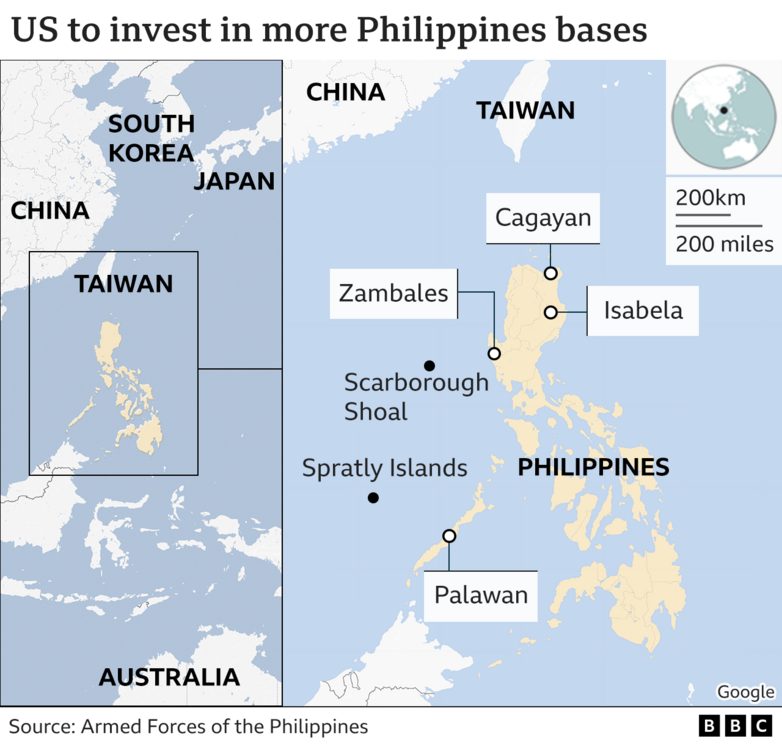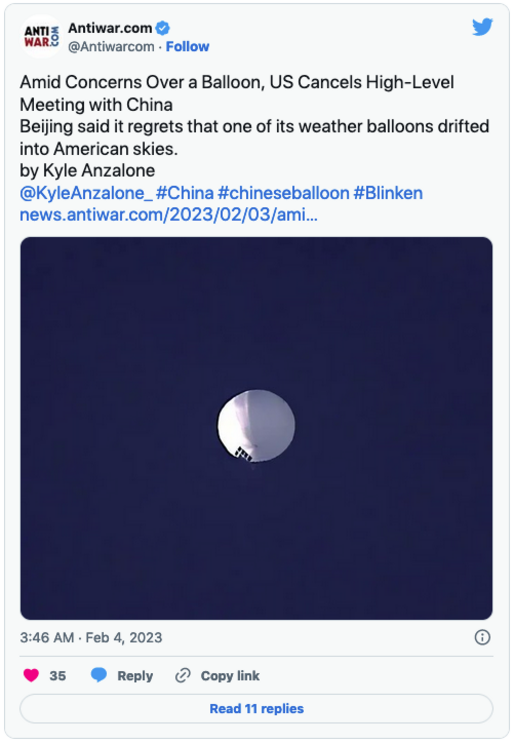US surrounds China with war machinery while freaking out about balloons
❖
In what Austin journalist Christopher Hooks has called “one of the stupidest news cycles in living memory,” the entire American political/media class is having an existential meltdown over what the Pentagon claims is a Chinese spy balloon detected in US airspace on Thursday.
Secretary of State Antony Blinken cancelled his scheduled diplomatic visit to China after the detection of the balloon. The mass media have been covering the story with breathless excitement. China hawk pundits have been pounding the war drums all day on any platform they can get to and accusing the Biden administration of not responding aggressively enough to the incident.
“The important thing that the American people need to understand, and what we are going to try to expose in a bipartisan fashion on this committee, is that the threat posed by the Chinese Communist Party is not just a distant threat in East Asia, or a threat to Taiwan,” House China Select Committee Chairman Mike Gallagher told Fox News on Friday. “It is a threat right here at home. It is a threat to American sovereignty, and it is a threat to the Midwest — in places like those that I live in.”
“A big Chinese balloon in the sky and millions of Chinese TikTok balloons on our phones,” tweeted Senator Mitt Romney. “Let’s shut them all down.”
China’s foreign ministry says the balloon is indeed from China but is “civilian in nature, used for meteorological and other scientific research,” and was simply blown far off course. This could of course be untrue — all major governments spy on each other constantly and China is no exception — but the Pentagon’s own assessment is that the balloon “does not create significant value added over and above what the PRC is likely able to collect through things like satellites in Low Earth Orbit.”
So everyone’s losing their minds over a balloon that in all probability would be mostly worthless for spying, even while everyone knows the US spies on China at every possible opportunity. US officials have complained to the press that American spies are having a much harder time conducting operations and recruiting assets in China than they used to because of measures the Chinese government has taken to thwart them, and in 2001 a US spy plane caused a major international incident when it collided with a Chinese military jet on China’s coastline, killing the pilot.
The US considers it its sovereign right to spy on any nation it chooses, and the average American tends more or less to see it the same way. This is highlighted in controversies around domestic versus foreign surveillance, for example; Americans were outraged over the Edward Snowden revelations not because spy agencies were conducting surveillance, but because they were conducting surveillance on American citizens. It’s just taken as a given that spying on foreigners is fine, so it’s a bit silly to react melodramatically when foreigners return the favor.
As Jake Werner explains for Responsible Statecraft:
Foreign surveillance of sensitive U.S. sites is not a new phenomenon. “It’s been a fact of life since the dawn of the nuclear age, and with the advent of satellite surveillance systems, it long ago became an everyday occurrence,” as my colleague and former CIA analyst George Beebe puts it.
U.S. surveillance of foreign countries is likewise quite common. Indeed, great powers gathering intelligence on each other is one of the more banal and universal facts of international relations. Major countries even spy on their own allies, as when U.S. intelligence bugged the cellphone of German Chancellor Angela Merkel.
Typically, even when such surveillance is directed against the United States by a rival power, it does not threaten the safety of Americans and it poses manageable risks to sites where secrecy is of the utmost importance. However — in the context of rapidly increasing U.S.–China tensions — foreseeable incidents like these can quickly balloon into dangerous confrontations.
Now let’s contrast all this with another news story that’s getting a lot less attention.
In an article titled “US secures deal on Philippines bases to complete arc around China,” the BBC reports that the empire will be adding even more installations to the already impressive military noose it has been constructing around the PRC.
“The US has secured access to four additional military bases in the Philippines – a key bit of real estate which would offer a front seat to monitor the Chinese in the South China Sea and around Taiwan,” writes the BBC’s Rupert Wingfield-Hayes. “With the deal, Washington has stitched the gap in the arc of US alliances stretching from South Korea and Japan in the north to Australia in the south. The missing link had been the Philippines, which borders two of the biggest potential flashpoints – Taiwan and the South China Sea.”
“The US hasn’t said where the new bases are but three of them could be on Luzon, an island on the northern edge of the Philippines, the only large piece of land close to Taiwan – if you don’t count China,” writes Wingfield-Hayes.
The BBC provides a helpful illustration to show how the US is completing its military encirclement, courtesy of the Armed Forces of the Philippines:

The US empire has been surrounding China with military bases and war machinery for many years, in ways Washington would never tolerate China doing in the nations and waters surrounding the United States. There is no question that the US is the aggressor in this increasingly hostile standoff between major powers. Yet we’re all meant to be freaking out about a balloon.
Ask me to show you how the US has been aggressing against China I can show you all the well-documented ways in which the US is encircling China with weapons of war. Ask an empire apologist to show you how China is aggressing against the US and they’ll start babbling about TikTok and balloons.
These things are not equal. Maybe Americans should stop watching out for hostile foreign threats and start looking a little closer to home.
...
My work is entirely reader-supported, so if you enjoyed this piece please consider sharing it around, following me on Facebook, Twitter, Soundcloud or YouTube, throwing some money into my tip jar on Ko-fi, Patreon or Paypal, or buying an issue of my monthly zine. If you want to read more you can buy my books. The best way to make sure you see the stuff I publish is to subscribe to the mailing list for at my website or on Substack, which will get you an email notification for everything I publish. Everyone, racist platforms excluded, has my permission to republish, use or translate any part of this work (or anything else I’ve written) in any way they like free of charge. For more info on who I am, where I stand, and what I’m trying to do with this platform, click here. All works co-authored with my husband Tim Foley.
Bitcoin donations:1Ac7PCQXoQoLA9Sh8fhAgiU3PHA2EX5Zm2
Liked it? Take a second to support Caitlin Johnstone on Patreon!



